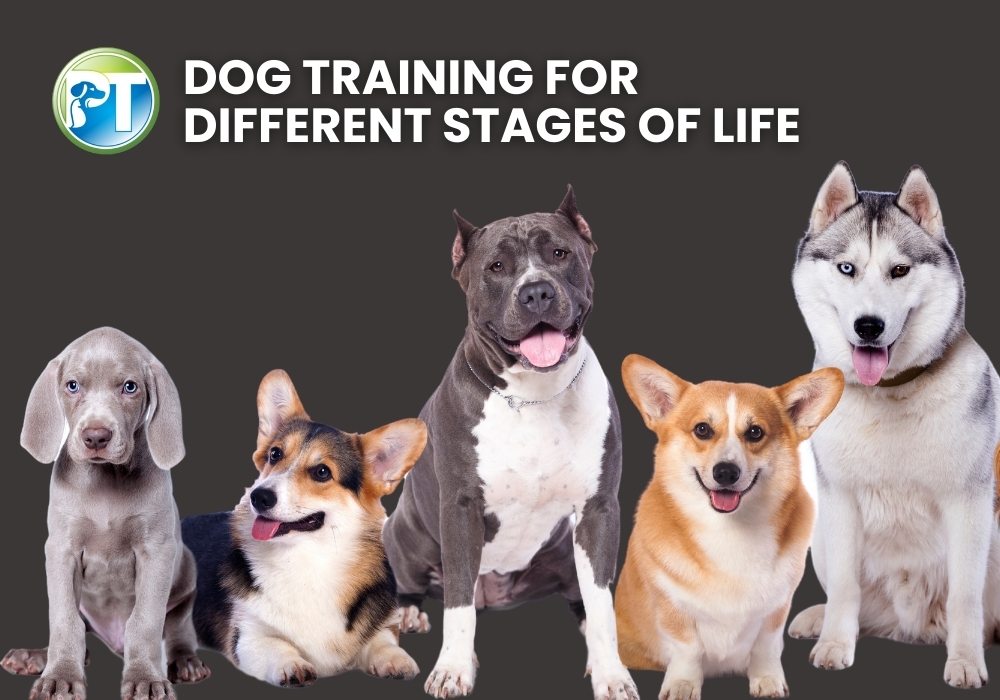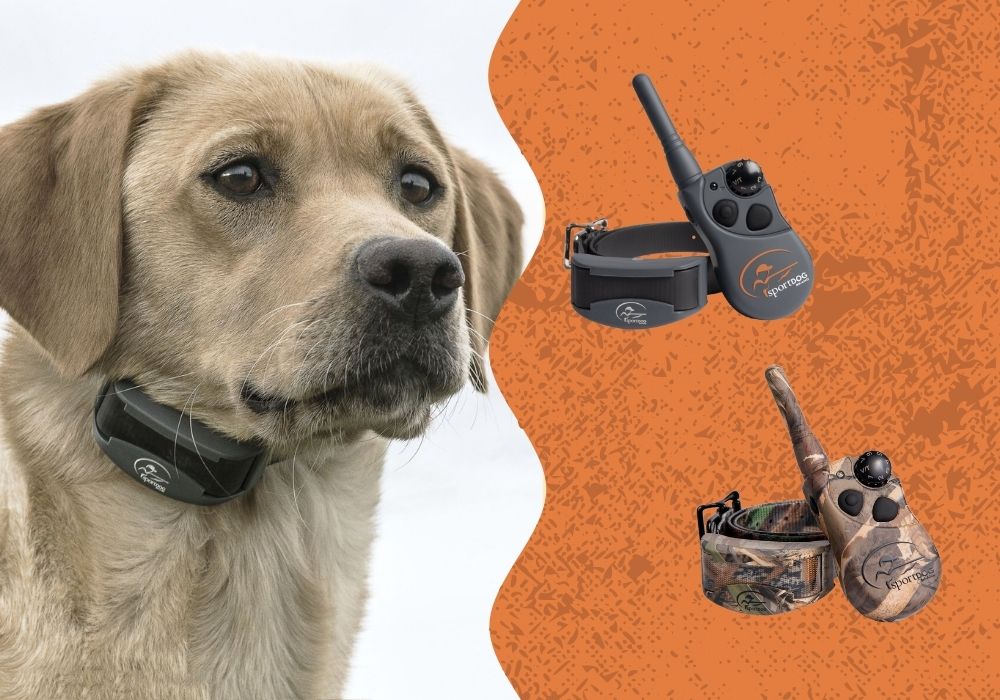Dog Training for Every Stage of Life: Puppy, Adolescent, Adult, and Senior

Did you know that dogs have unique training needs at different stages of life? As dogs age, their training needs evolve to meet their changing physical and mental abilities.
In this blog post, we will discuss the importance of dog training for different stages of life. We will also give you some easy tips for training your dog at each stage.
Different Stages of a Dog's Life
A dog's life has four main stages: puppyhood, adolescence, adulthood, and senior age. Each stage has its own specific training needs.
I. Puppyhood: Building a Strong Foundation

Puppyhood ranges from a dog’s birth until adolescence. It is a time of rapid growth and development, both physically and mentally. Puppies are naturally inquisitive and love to learn new skills. This stage is about setting a solid foundation for their future behaviors.
-
Basic Obedience Commands
The most important commands for puppies to learn are “sit,” “stay,” “come,” and “down.” These commands will help keep your puppy safe and under control in various situations. For example, if you're at the vet's office and your puppy is scared, you can tell them to lay down to help them feel more relaxed.

-
Socialization
Socialization is as crucial as obedience training for puppies. It teaches them how to have positive interactions with people and other animals. This will help them become well-adjusted dogs who are comfortable in various environments.

-
Crate Training
Crate training can be a great way to help puppies learn to feel comfortable being alone. It can also be helpful for housebreaking, as puppies are less likely to soil their crates.
When crate training your puppy, it is important to make the crate a positive experience for them. Provide your dog with a comfortable bed, toys, and treats. You should also never use the crate as punishment.

-
Housebreaking
Housebreaking or potty training is another essential part of puppy training. With consistent positive reinforcement, most puppies can be potty trained by the time they are 6 months old. The best way to housebreak your puppy is to regularly take them outside to potty. You should also praise and reward your puppy when they go potty outside.

Here are some of the challenges you may face when training your dog during puppyhood:
II. Adolescence: Navigating the Teenage Years

Adolescence is the period in a dog's life when they are transitioning from puppyhood to adulthood. This stage typically spans from 6 to 12 months. During adolescence, dogs undergo many physical and hormonal changes, making them seem more rebellious and difficult to train.
-
Reinforcing Basic Commands
Since dogs experience hormonal changes during this stage, they may be more rebellious and difficult to train. By continuing to work on basic obedience commands, you can help your dog stay focused and obedient, even during this challenging time.

Also, you can start teaching your dog more advanced commands, such as “heel” and “leave it.” The “heel” command helps keep your dog close to you when walking in a busy area. The leave it command can help prevent your dog from chewing something that could be harmful to them. This includes things like poisonous plants, trash, or even food that has been dropped on the ground.
-
Leash Training
Leash training teaches your dog to walk calmly beside you on a leash. It is an opportunity to train your dog to walk without pulling, lunging, or reacting to every distraction they encounter. Leash training aims to make walks enjoyable and stress-free for you and your dog.

-
Impulse Control
Impulse control refers to your dog's ability to manage their impulses, exercise self-restraint, and make well-considered decisions. This is especially important during adolescence when dogs are full of energy and easily distracted. They may be more likely to act impulsively in response to stimuli in their environment, such as other animals, people, or objects.

Impulse Control Training Tips
Here are some of the challenges you may face when training your dog during adolescence:
- Your dog may start to test their boundaries.
This is a normal part of adolescence, but it can be frustrating for dog owners. Being patient and consistent with your training is crucial during this time.
- Your dog may be more distracted than when they were a puppy.
Adolescent dogs are more interested in exploring their surroundings and interacting with other dogs and people. Be prepared for distractions when you are training your dog during this time.
- Your dog may be more stubborn than before.
This is because they are starting to develop their own personality and opinions. Be patient and persistent with your training during this time.
Dog Training Aids for Impulse Control and Reinforcing Dog Commands
Dog electric collars, also known as e-collars or remote dog training collars, are electronic devices that use a mild electric pulse to communicate with dogs. These collars can be used to provide gentle corrections during training, as well as to reinforce commands and address unwanted behaviors.

E collars for dogs are most commonly introduced during adolescence. This stage is crucial as your dog begins to test boundaries and solidify behaviors.
Best E Collars for Dog Training
If you're on the fence of what e collar to choose, we got you covered:
1. SportDOG FieldTrainer 425X Remote Training Collar

The FieldTrainer 425X is the smallest and lightest remote trainer yet by SportDog. This SportDog collar is great for field training and hunting with close-working dogs. This is also perfect for dogs learning basic obedience or more advanced commands.
Features:
- 500-Yard Range
- Three (3) Training Modes – tone, vibration, and static stimulation
- 21 Levels of Static Stimulation
- Waterproof and Submersible up to 25 Feet
- Rechargeable Batteries
- Low Battery Indicator
- Expandable to a 3-Dog System
- For Dogs as Small as 8 Pounds
2. SportDOG FieldTrainer 425XS Remote Training Collar

The SportDOG FieldTrainer 425XS is a lightweight e-collar ideal for on-the-field and hunting dog training. Designed for stubborn and high-drive dogs, this shock collar has a static stimulation range higher than the popular SD-425X.
Features:
- 500-Yard Range
- For High-Drive and Stubborn Dogs
- 21 Levels of Static Stimulation
- Pager Vibration
- Tone Feature
- Waterproof
- Rechargeable Batteries
- Expandable to 3-Dogs System
- For Dogs 8 Pounds and Up
3. SportDog WetlandHunter 425XCamo Remote Training Collar

The WetlandHunter 425X Camo is perfect for both field training and hunting. The camo finish makes it ideal for use in the wetlands, making it the perfect tool for waterfowl hunting.
Features:
- 500-Yard Range
- Realtree Max-5 Camo Finish
- 21 Levels of Static Stimulation
- Pager Vibration
- Tone Feature
- Waterproof
- Rechargeable
- Expandable to 3-Dogs System
- For Dogs 8 Pounds and Up
III. Adulthood: Refining Skills and Behaviors

Adulthood in dogs typically spans from 1 to 7 years old. However, the age range varies significantly depending on the breed of the dog. For instance, smaller dogs tend to reach adulthood at an earlier age than larger dogs. Adult dogs are typically fully grown when they have reached their full height and weight.
Adult dogs are typically easier to train than puppies or adolescents. They are more focused, and it is easier to get their attention. This is the perfect time to continue working on basic and advanced obedience commands.
-
Recall Training
Recall training teaches your dog to return to you when you call them. It is crucial for safety, especially if you plan on letting your dog off-leash in a safe area. This skill is particularly useful in emergency situations, such as encountering traffic or wildlife.

Recall Training Steps
-
Addressing Separation Anxiety
Separation anxiety is a condition wherein dogs feel distressed when separated from their owners.

Dogs with separation anxiety may exhibit a variety of behaviors, such as:
- Destructive behavior: This includes chewing, digging, scratching, or destroying furniture or other objects.
- Excessive vocalization: Dogs may bark, whine, or howl excessively when stressed.
- Urinating or defecating in the house: This is often done out of anxiety or stress.
- Pacing or excessive whining: This signifies the dog is trying to cope with their anxiety.
- Self-injury: Some dogs may lick or bite themselves excessively when they are anxious.
There are a number of things you can do to help your dog overcome or prevent separation anxiety. For instance, refrain from making a fuss when you leave or come back to reinforce the idea that being alone is normal. You can also give them toys and treats to stay occupied.
-
Mental and Physical Enrichment
Adult dogs need mental and physical enrichment, just like puppies and adolescents. This can help to keep them healthy and happy.
Mental enrichment helps prevent boredom and keep your dog's mind active. When dogs are bored, they may exhibit destructive behaviors or develop other problems. Mental enrichment can prevent these problems by providing dogs with challenges and activities to stimulate their minds.
- Sniffing Games: Dogs have a keen sense of smell, so sniffing games can be a great way to mentally stimulate them. You can hide treats around your home and let your dog sniff them out.
- Interactive Toys: You can find toys that keep your dog's mind busy. These toys make your dog figure out puzzles or do something to get their food. This can stop them from getting bored and doing things that cause trouble.

Physical enrichment helps keep dogs healthy and fit. When dogs don't get enough exercise, they may become overweight or develop other health problems.
- Exercise: Adult dogs may need at least 30 minutes of exercise per day.
- Playtime: Playtime is a great way for dogs to get exercise and have fun. You can play fetch, tug-of-war, or even just go for a walk around the block.
- Hiking: Hiking is a fun and rewarding activity that allows dogs to get exercise and explore the outdoors.
- Training: Training can also be a form of physical enrichment for dogs. When your dog is working on a new command, they use their body and mind.
- Swimming: Swimming can help dogs to stay cool and active on hot days.

Here are some of the challenges you may face when training your dog during adulthood:
- Your adult dog may be less motivated to learn new things because they have already learned a lot in their life.
- Your dog may be more set in their ways because they have already developed routines and habits.
- Your dog may have health problems. Adult dogs are more likely to have health problems than puppies. These problems can make it challenging to train them.
IV. Senior Age: Nurturing Comfort and Well-Being

Senior stage typically spans from 7 years up to the life expectancy of a dog. However, the age range may differ based on their breed. For example, smaller dogs may reach this stage at an earlier age than larger dogs.
Older dogs are less active, have diminished senses, and experience cognitive decline. They may require more rest during training sessions and should only focus on basic obedience commands.
-
Basic Obedience Commands
In training senior dogs, the spotlight shifts to reinforcing the commands they've mastered throughout their lives. They may be unable to learn new commands as quickly as they used to. Instead, focus on strengthening basic obedience commands that they already know.
-
Low-Impact Exercise
Older dogs still require physical activity. However, it is crucial to opt for low-impact exercises to ensure their safety and well-being.
Some good options for old dogs include:

- Walking
- Swimming
- Playing fetch
- Tugging
-
Mental Stimulation
Senior dogs still need mental stimulation, even if they are not as active as they used to be. Some good ways to mentally stimulate old dogs include puzzles and interactive toys.
-
Health Considerations
As dogs age, they may develop health problems. It's vital to be aware of any challenges your dog may have and adjust your training accordingly. For example, if your dog has arthritis, you may need to avoid activities that put too much stress on their joints.

Here are some of the challenges you may face when training your dog during senior age:
- Your senior dog may experience physical and cognitive decline, including slower reflexes, reduced energy, and difficulty seeing or hearing. Additionally, cognitive decline may make it difficult to learn new things.
- Your senior dog may have more health problems, making training difficult.
Final Word
Remember, dog training is a lifelong process. Training dogs at different stages of life is important because their needs change as they age.
You might also enjoy...
-
Posted in
Obedience Training, Remote Training Collar, Training Tips


